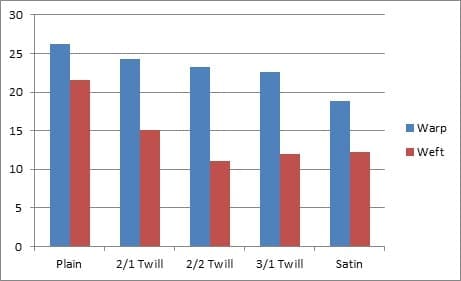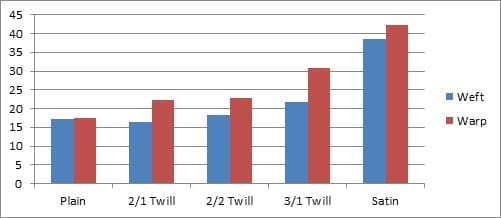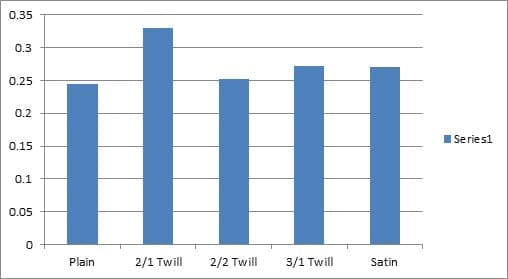Mr. Ganesh Jadhav (Manager-TRADC), Ms. Ankita Kaushik (Asst. Manager-TRADC)
INTRODUCTION
There are seven major parameters of a fabric structure which govern the properties of the fabric – type of fibre, linear density of yarn, epi x ppi and fabric weave. The weave of a fabric depends on its end use, which impacts the functional and aesthetic properties of the fabric to a greater extent. Therefore a coherent design of a fabric involves understanding of correlation between fabric structure and its functional as well as aesthetic properties. The properties of a fabric vary with weave due to introduction of parameters like float length and number of cross-over points. The purpose of this study is to investigate the effect of weave on different physical properties of fabric.
METHODOLOGY
The weaves considered for this study were Plain, 2/1 Twill, 2/2 Twill, 3/1 Twill and 5E Satin. All the fabrics have same fibre, count and construction – 30s Modal having a construction of 72 x 72, along with same machine parameters. The weave designs of the fabrics are shown in the figures 1, 2, 3, 4, 5.
Table 1. Fabric Parameters
The yarns were sized prior to weaving. The size box is electrically heated and the temperature is electronically controlled. Roller type electrically-heated drying through contact is achieved. The size recipe that was taken is as follows:
Table 2. Sizing recipe
The trials were taken on CCI Automatic Sampling Loom SL8900. Details of the loom are given below:
Table 3. Loom parameters of CCI Automatic Sampling Loom SL8900
After being woven, the fabrics were pre-treated with identical processing conditions and parameters.
Table 4. Wet Process Route and Recipe
All tests were carried out under alike testing conditions i.e. 27 ± 2 °C temperature and 65% Relative Humidity.
RESULTS AND DISCUSSIONS
Table 5. Test Results
- Shrinkage
Testing the effect of washing and drying on dimensional stability of the fabric gives information about the fabric types and is thus useful for the end consumer. It is observed that type of weave has a significant effect on the dimensional behavior of fabrics. Plain weave is showing the lowest shrinkage because of higher number of interlacement points. On the other hand, satin weave with the lowest number of interlacement points has shown the highest shrinkage.
Figure 6. Effect of weave on shrinkage
2. Tensile Strength
Tensile strength can be defined as maximum load a test specimen can withstand when subjected to uni-axial loading. The strength of fabric depends not only on yarn strength and its constituting fibre’s strength but also on its fabric structure. Plain woven fabrics tend to show highest tensile strength as the interlacement points are more, providing a higher contact area, hence leading to greater frictional force and resistance to slippage of yarns in the fabric. On the other hand, tensile strength decreases as we go from plain to twill and to satin, reason being increasing floats and lesser binding points.
Figure 7. Effect of weave on tensile strength
3. Tearing Strength
The results illustrate highest tearing strength in satin fabric followed by 3/1 twill, 2/2 twill, 2/1 Twill and plain woven fabrics. 2/2 twill and 2/1 Twill fabrics show nearly same strength values. The reason being the loose structure (long floats) of satin fabric which gives chance for grouping of threads to occur, resulting in high tear resistance. While in plain fabrics, as the binding points are relatively more, the thread movement decreases, hence tearing resistance drops.
Figure 8. Effect of weave on tearing strength
4.Water Absorbency
There are several factors which affect water absorbency like fibre type, GSM, thickness of fabric and weave. It is seen that as the float decreases, the pore size in the fabric decreases. And as the fabric is wetted, the yarns swell, thus blocking the pores in between them. Therefore, a loosely woven fabric is prone to have higher water absorbency, as depicted in the below graph.
Figure 10. Effect of weave on water absorbency
5. Air Permeability
Air permeability is another property that depends on size of pores and inter-thread channels in a fabric which are reliant on fabric structure. It can be clearly seen from the figure, the air permeability increases with increase in float length as the increment in float length makes the fabric loose to allow air to penetrate through it, and vice-versa.
Figure 11. Effect of weave on air permeability
CONCLUSION
The forgoing discussion gives an idea about the relation between fabric structure and its properties which is wrapped up as below:
- As the number of interlacement points in the weave increase, the fabric shrinkage lowers after processing, while its tensile strength increases.
- Loose structure of fabric results into high tearing strength because of grouping of threads when the load is applied. On the other hand, an increase in number of binding points in the structure restricts the thread movement, thus reducing the tearing strength of the fabric.
- A fabric with higher floats is likely to absorb more water as compared to that with that is tightly constructed with more binding points, because a fabric with more binding points and tight construction has smaller pore size which decreases further as the fabric gets wet due to swelling of constituting yarns.
- Likewise, air permeability also depends on pore size and is found to be more in fabrics with more number of floats.












